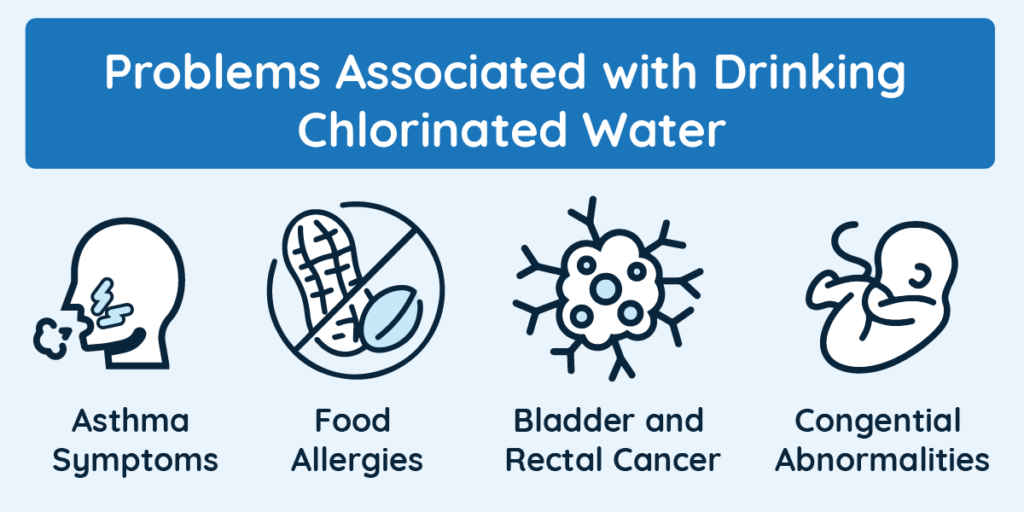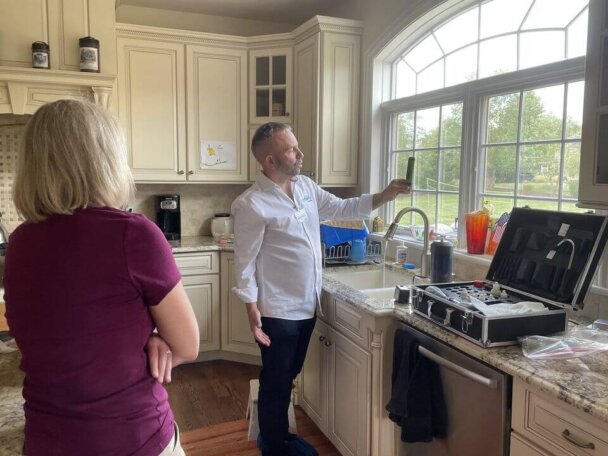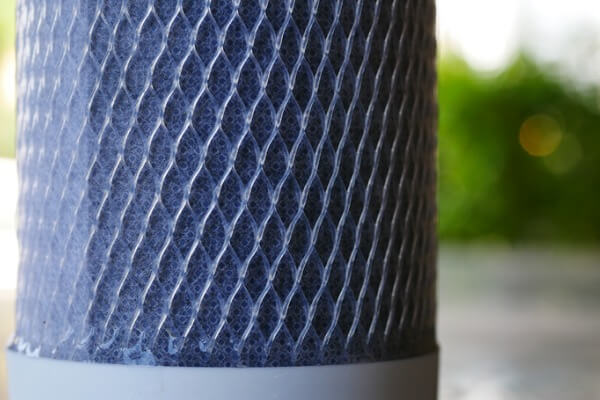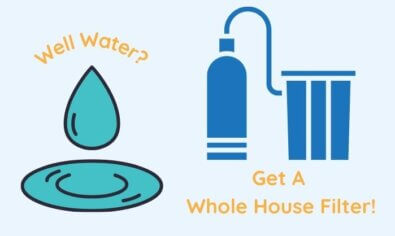Remove Chlorine from Water with a Reverse Osmosis System
This post features the following key takeaways:
- Chlorine and chloramine in drinking water can cause many health problems, including asthma and cancer.
- A reverse osmosis system removes chlorine and chloramine from water for you with a scientifically proven process.
- The best reverse osmosis systems are NSF/ANSI 58 certified.
- Angel Water can install a quality reverse osmosis system in your home for you.

The importance of water echoes through schools, homes and businesses across the US. Many of us even have apps installed on our phones to remind us to drink enough throughout the day.
Yet so many Americans are drinking contaminated water in their homes. Two culprits that we often find in our water are chlorine and chloramine.
You may be surprised to learn that these potentially harmful pollutants get into our water because we put them there.
Most municipal treatment plants use chlorine and chloramine to disinfect water before sending it to homes. This treatment protects against many harmful waterborne illnesses. However, as we’ll see, chlorinated water isn’t the safest to consume.
Fortunately, a simple water treatment solution exists to remove chlorine and chloramine from drinking water: a reverse osmosis (RO) system. In this post, we’ll show you how an RO system can eliminate the harmful effects of chlorine and chloramine in the water.
Interested in reverse osmosis for your home? Visit our service page to find out how our licensed professionals can get you the proven system you need.
The Problems with Chlorine in the Drinking Water
Municipalities throughout the US add certain amounts of chlorine and chloramine to the water system to remove harmful microorganisms. However, chlorine and chloramine can also cause some problems of their own.
At the concentrations found in drinking water, chlorine and chloramine are not toxic to people. We even use them in our swimming pools, the very place where our children play day in and day out.
However, even though diluted chlorine and chloramine are non-toxic, they can still have harmful effects.
Let’s look at some of the potentially harmful effects that can come about from drinking water with chlorine and chloramine in it.
Asthma Symptoms
One of the potential problems that have been linked to chlorine in water is the exacerbation of asthma symptoms.
Just looking at swimming pools alone. Studies conducted have shown that chlorinated water can increase exercise-induced asthma symptoms, even in people who have never had such symptoms before.
One of the main issues with chlorine and chloramine in our drinking water is that when we bathe or shower, we absorb the contaminants into our skin. We also breathe in chlorinated steam, which can significantly aggravate any asthma symptoms already existing.
Food Allergies
Another potential issue that has been linked to chlorine in water is the development of food allergies.
A study published in Clinical & Experimental Allergy found a link between the two, with children who were exposed to chlorinated water being more likely to develop food allergies later in life.
While more research needs to be done to confirm these findings, it’s still something that’s worth taking into consideration.
Bladder and Rectal Cancer
One of the more serious potential problems with chlorine and chloramine in water is an increased risk for bladder and rectal cancer.
A study published in the American Journal of Epidemiology found that those who drank chlorinated water were more likely to develop bladder cancer when compared to those who didn’t drink it.
Even though more studies need to be done here as well, these findings shouldn’t be ignored.
Congenital Abnormalities
Another potential problem that has been linked to chlorine and chloramine in water is an increased risk for congenital abnormalities.
A study conducted in Taiwan of almost 400,000 people revealed that pregnant women who were exposed to the trihalomethanes found in chlorinated water were more likely to have children with abnormalities. These include a hole in the heart, cleft palate and lack of brain development.
If you feel like we’ve scared you off drinking water ever again, don’t panic! There are ways you can remove chlorine and chloramine from your water to make it safe to drink. While some of these methods take extra effort, such as boiling your water before you drink it, there is one simple alternative: reverse osmosis (RO).

How to Dechlorinate Water Easily with a Reverse Osmosis System
If you’re worried about the chlorine and chloramine in tap water and wondering how to remove it, then reverse osmosis is the solution. A certified reverse osmosis system is one of the most popular ways to remove pollutants from water. It’s also one of the easiest if you have the right equipment.
Reverse osmosis works by using a semi-permeable membrane to remove impurities from water. The impurities are flushed away, leaving behind clean, chlorine-free water. It’s a simple way to dechlorinate tap water.
RO systems are effective at removing a variety of other impurities from water as well, including, lead, fluoride, arsenic, and sodium.
Let’s unpack exactly how a reverse osmosis system works.
Unsure About Your Water Quality? Get a Free Water Test Today!
Contaminants can affect the safety and taste of your water. Get a free water test to check your water quality and see if a reverse osmosis system can help provide clean, pure drinking water.

How a Reverse Osmosis System Works
While it may sound complicated, it’s not. To understand how a reverse osmosis system works, it’s important that you know the difference between diffusion, osmosis, and reverse osmosis.
What is Diffusion?
Diffusion is the movement of particles from an area of high concentration to an area of low concentration. Think about when you release gas in a room. It doesn’t sit in one place but rather spreads itself evenly throughout the room. It’s the same thing with water.
Water molecules will move to an area of less concentration until everything is balanced.
What is Osmosis?
Osmosis is a type of diffusion that specifically refers to the movement of water molecules. It occurs when there is a difference in water concentration on either side of a semi-permeable membrane.
The water molecules will move from an area of high concentration (less pure water) to an area of low concentration (more pure water). This will continue until the concentrations are equalized.
What is Reverse Osmosis?
Now that you know how diffusion and osmosis work, it’s time to talk about reverse osmosis.
Reverse osmosis is, quite simply, the opposite of osmosis. Instead of water molecules moving from an area of high concentration to an area of low concentration, they move from an area of low concentration to an area of high concentration.
This is only possible because reverse osmosis systems have semi-permeable membranes that only allow water molecules to pass through. The impurities in the water are too large to pass through the pores of the membrane, so they are trapped on one side.
The water molecules move from the less pure side (high concentration) to the purer side (low concentration), leaving the impurities behind.
Reverse osmosis systems have a few different parts, but the most important is the semi-permeable membrane. This is what does all the work in removing impurities from your water.

The Components of a Reverse Osmosis System
Reverse osmosis systems consist of a sediment filter, a pre-carbon filter, a semi-permeable membrane and a post-carbon filter. Here’s how the components work together to purify the water:
- The water first passes through the sediment filter, which removes any large particles from the water, such as dirt or sand.
- Next, the pre-carbon filter removes any chlorine and chloramine from the water.
- The water then passes through the semi-permeable membrane, which filters out all impurities.
- A post-carbon filter removes any final remaining impurities from the water.
- The result is clean, chlorine-free water that is safe to drink.
Reverse osmosis systems are a popular choice for those looking to remove chlorine and chloramine from their water because they are effective and easy to use. So, if you’re looking for a simple way to remove chlorine and chloramine from your water, a reverse osmosis system is a great option.
Want to keep up with the latest reverse osmosis news?
Sign up for our free email newsletter to get updates about RO systems and more delivered to your inbox!
Which RO System is Best to Dechlorinate Tap Water in My Home?
Not all RO systems are created equal! The highest quality systems have NSF/ANSI 58 certification. NSF is a third-party nonprofit organization that certifies products to ensure they meet certain standards. When it comes to reverse osmosis systems, you want to make sure the system you choose is certified to remove chlorine and chloramine from your water.
You should also look for a system that has a low maintenance requirement. Reverse osmosis systems require periodic filter changes, but some systems are easier to maintain than others. Look for a system with filters you can change easily and don’t need to replace too often.
Keep in mind that less expensive filters require changing every three months; whereas, you only need to replace more expensive filters once a year. So, the extra cost can be worth it for the lower maintenance requirements.

Higher Quality Reverse Osmosis Systems
Reverse osmosis filters are extremely effective at removing minerals like chlorine from water. In fact, we’d go so far as to say it’s too effective because it not only removes the harmful minerals but also the ones that are good for you. For this reason, some people have criticized the water RO filters produce, calling it “dead water” since it contains no beneficial nutrients.
Fortunately, higher quality reverse osmosis systems are available to fix this problem. They do so by adding healthy minerals back into the water after the filtration process is complete. As a result, the water is not only free from impurities but also contains the minerals your body needs to thrive!
One example of an RO filter that does this is the PurAsure RO Alkaline System. This system increases the water’s pH after filtering it, which turns it into alkaline water. Studies have shown that alkaline water may be linked to significant health benefits, such as fighting off cancer.
Need Help Removing Chlorine from Your Tap Water?
If you are looking to remove chlorine in tap water, as well as other contaminants, then you need to have a reverse osmosis system from Angel Water installed in your home.
Here are some of the contaminants that our PurAsure ERO and PurAsure HERO-385 systems can remove:
- Fluoride
- Iron
- Manganese
- Lead
- Nitrates
- Arsenic
- Mercury
- Trihalomethanes
- Cyanide
- Zinc!
- Chloride
- Chromium-6
- And more
Would you want any of those in your drinking water? Are they already in your drinking water? If you want complete peace of mind that you and your family are drinking pure water in your home, then you need an Angel Water PurAsure system.
Our reserve osmosis systems use NSF-certified carbon materials to ensure the highest quality. They also continuously monitor water usage to ensure effective and efficient water treatment.
Want to learn more about the reverse osmosis system services we offer? Call 847-382-7800 to speak to an expert or visit our product page at the link below.
Ready for Cleaner Water? Schedule an Appointment Now!
Ensure your family has access to clean, great-tasting water. Schedule an appointment with our specialists today to learn how a reverse osmosis system can purify your drinking water.



